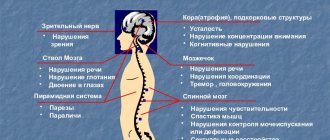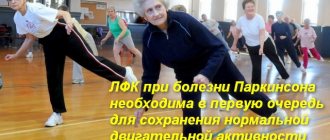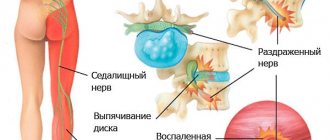Multiple sclerosis (MS) is a severe, disabling disease of the nervous system that most often affects young and middle-aged people. Due to the fact that the exact cause of this disease has not yet been identified, its complete cure is impossible. Nevertheless, drug therapy, physical rehabilitation, and exercises recommended for multiple sclerosis can slow down the progression of the process.
Why is physical exercise needed for MS?
The essence of the disease is the development of an autoimmune reaction: the body’s own immune cells damage the sheath of the nerve fibers of the brain and spinal cord. The conduction of the impulse slows down, and a variety of MS symptoms appear, directly depending on the location of the damage:
- Decreased muscle strength in the trunk and limbs;
- Movement coordination disorders;
- Blurred vision;
- Change in sensitivity;
- Speech impairment;
- Seizures;
- Urinary and fecal incontinence;
- Intellectual decline (patients are slow to think and quickly forget the simplest things);
- Mental instability.
It is very important to start treatment in time, when it is still possible to reverse the process. In addition to special medications, physical therapy, which doctors prescribe for multiple sclerosis, plays an important role. It is necessary for the formation of feedback: when you perform any set of exercises, a nerve impulse from the working muscle enters the brain and stimulates the areas that are responsible specifically for its activity.
Even if a certain area of the brain is damaged, neighboring areas can partially take over its function. But for this, training must be regular and systematic. A physical therapy doctor will help you choose the right set of physical therapy for patients with multiple sclerosis.
Another problem is that, against the background of the appearance of muscle weakness (paresis) and disturbances in the mechanism of movement, secondary changes begin in the musculoskeletal system. Due to improper load on the joints and spine, the first signs of osteochondrosis and arthrosis appear - narrowing of the joint space and subchondral sclerosis of the endplates on an x-ray. Adequate physical activity will help avoid such complications.
Exercises to improve endurance
Exercise for multiple sclerosis is divided into several subtypes. One of its most important components is endurance exercises. They are needed for the following purposes:
- Giving additional strength to the upper and lower extremities;
- Increased walking speed;
- Additional benefits for the body are reduced fatigue and improved quality of life.
For example, an exercise to hold the body on the limbs is effective. To perform it, you need to rise on your tiptoes as high as possible and hold your own body in this position for 10-15 seconds. Then you need to lower yourself and rise again, but this time leaning only on your heels. Gradually the load can be increased to 3 approaches of 30-60 seconds.
To train the hand, a similar exercise to hold the body while standing in a support is suitable. In this case, the legs can be straightened or bent at the knees, but the body weight should be supported only on the arms.
Experienced neurologists recommend walking up stairs as an exercise for multiple sclerosis to develop endurance, but it is not suitable for everyone due to the individual characteristics of the patient’s body.
General principles of therapeutic exercises for patients with multiple sclerosis
During the treatment of multiple sclerosis with physical activity, you need to adhere to some general recommendations:
- Strictly dose physical activity; you should not overwork. If signs of fatigue appear, you should stop training.
- Each patient requires an individual approach. Manifestations of multiple sclerosis are very diverse, both in the severity of symptoms and in their essence. A gymnastics complex for a patient with coordination disorders will be significantly different from a workout with paralysis of half the body.
- Moving from one position to another during exercise must be done with great care. Use support if necessary.
- There is no need to exercise just before going to bed - this can cause insomnia.
- For paresis, a combination of massage and exercise therapy is effective.
- Make sure you breathe correctly during exercise, it will make the workout much more effective.
Features of the action of body temperature
Experienced neurologists have proven that approximately 60-80% of patients with multiple sclerosis experience an increase in body temperature. This is due to performing physical activities that are unusual for the body. It is worth noting that, basically, this only happens in the early stages of training and gradually goes away.
Multiple sclerosis is one of the most common neurological diseases, which is quite difficult to treat. Only complex therapy, one of the components of which is physical therapy, can alleviate the patient’s well-being.
Advantages
Exercise therapy for MS has a number of serious advantages:
- Maintains physical fitness and ability to move;
- Prevents the formation of contractures;
- Tones, increases performance;
- Improves coordination;
- Helps cope with the problem of urinary incontinence by strengthening the muscles of the bladder and rectum;
- Develops the ability to correctly hold a certain body position;
- Normalizes blood supply to the brain and increases its resistance to disease;
- Maintains intelligence for a long time.
This is interesting!
Physical training promotes the production of endorphins - joy hormones - in the brain, which means a lot for patients with multiple sclerosis. According to statistics, 15% of such patients die due to suicide due to prolonged depression. Exercise therapy helps fight anxiety and stress, improves overall mood.
Exercises at home
Of course, any therapeutic exercise will be effective in the gym. But, if it is not possible to attend, then you need to study at home. It is recommended to regularly perform aerobic and anaerobic exercise on the body. Firstly, they help strengthen muscles and the body, and secondly, they improve mobility and coordination of movements. In addition, rhythmic movements have a positive effect on brain function and psychosocial functioning.
The peculiarity of aerobics is to perform certain monotonous movements at a fast pace. Fortunately, in the modern world it is easy to find any method and program on the Internet. You just need to turn on the video and repeat the action after a professional trainer. An excellent alternative to such activities is light jogging or brisk walking, skiing or cycling. Walking in the fresh air has a particularly beneficial effect on a person’s well-being.
The obvious disadvantage of training at home is that the person will be training alone. Firstly, he will not be able to assess the correctness of the exercises in this way, and, secondly, if he suddenly becomes ill, then there may not be someone nearby to provide first aid. Therefore, it is still recommended to practice under the supervision of a specialist.
A set of exercises recommended for multiple sclerosis
The time of one session of therapeutic exercises performed for multiple sclerosis should not exceed a quarter of an hour. It is advisable to train at least 2 times a day. The pace of execution is leisurely, with rest breaks. It is advisable to alternate active and relaxing elements.
Important!
Throughout the entire workout, you need to monitor your condition and intensity of the load. Since a sick person is not always able to objectively assess the degree of his fatigue, counting his pulse comes to the rescue. A heart rate from 100 to 130 beats per minute indicates a low intensity of exercise, from 130 to 150 – average (optimal), from 150 to 170 – excessive, over 180 – maximum.
Exercises that are performed in the starting position (IP) lying down
Each task must be repeated 3-8 times, depending on the severity of the condition.
- Bend your knees, spread them slightly and place your feet on the floor. Take turns pulling your hips towards your stomach, helping with your hands if necessary.
- From the previous position, tilt both legs, now to the right, now to the left, without lifting your feet, pelvis and entire body from the floor.
- Bring your feet even closer to your buttocks. Raise your pelvis up without lifting your shoulder blades from the horizontal surface.
- Perform the “Bicycle” exercise, simulating pressing the pedals.
- Now do the same exercise, but with one leg - first the right, then the left.
- Lie down straight, legs together, arms out to the sides, palms up. As you twist your spine, cover the palm of one hand with the other. Then vice versa.
- Roll over onto your stomach, rest your head on your forearms. Place your feet parallel to each other, resting on your toes. Lift your right foot from the support, move it over your left, and touch your toes to the floor. Then repeat with your left leg.
- Imitate breaststroke swimming: extend your arms straight forward, then spread them to the sides, raising your head and shoulders. Having made a full circle, extend your arms along your body and bring them forward again.
The following exercises can be performed either lying or sitting
This section contains a number of exercises that are performed with the help of a chair and a gymnastic stick. These exercises can be performed both lying down (against the background of a serious condition) and sitting, if this possibility is preserved. 3 to 8 approaches should also be done.
- Alternately stretch your arms straight up at the elbow and wrist joints.
- Hold a gymnastic stick in your hands so that your upper limbs are parallel to each other. As you inhale, slowly raise it above your head, and as you exhale, lower it.
- At the same time, move the limbs of the same name in your direction.
- Now move the opposite limbs away. For example, the right hand and left leg and vice versa.
- Bend your elbows with support on the bed or armrest. Alternately connect the pads of your thumbs with all the others.
- In the same position, rotate your brushes clockwise and then counterclockwise. Do 4 circles for 3-8 approaches.
- As you exhale, clasp your torso with your arms and pull your feet towards you. As you inhale, lower your arms and spread your feet.
- We clench the fingers of our right hand into a fist and bend our right foot towards ourselves. At this time, the left palm is open and the left foot is bent away from you. Then we swap the limbs: the left hand and foot are bent, the right ones are extended.
Exercises that are performed in the starting position (IP) while sitting
These tasks are intended for patients who have retained the ability to sit and maintain balance. The number of repetitions is similar – from 3 to 8.
- Sit straight on a chair with a back, lower your arms parallel to your body. Lean forward slightly, lifting yourself off the backrest, then lean back again. In this case, the position of the head and spine should remain level, and there should be no symptoms of dizziness or balance disorders.
- Take a gymnastic stick. Hold it with both hands, placing it on the weight perpendicular to the floor. Touching with straightened arms, move it down and up.
- Now you need to move to the sofa or bed. Smoothly bend your body sideways, while your hands slide along the horizontal surface without leaning on it.
- Transfer body weight from one buttock to the other. Control the condition of the muscles: they should hold the torso upright, only the buttocks move.
- Sit at the table. Place your hands on a soft cloth and stretch forward, sliding them along the table along with the rag, then sit up straight again.
- Place your forearms on the table. Grasp the rolling pin with your palm, holding it at a right angle to the tabletop. Turn the brush so that the rolling pin rests on a horizontal surface, then return it back. Duplicate with your other hand.
- Now hold the rolling pin with both hands, parallel to the table. Forearms lie on a hard surface. Raise the rolling pin up, bending only your hands at the wrist joints.
- Place your hands on your knee joints, lean on them and slowly stand up, straighten up, stand for about 3-5 seconds and slowly sit down again. Then try to complete this task without using your hands, tensing only the muscles of your legs and torso.
After training, take slow breaths in and out for a minute, calming your breathing.
If you have been diagnosed with such a serious diagnosis as multiple sclerosis, you should never despair. The disease progresses differently for everyone; many retain the ability to move and even work until old age. It is important to follow all medical recommendations, do not forget about training and maintain a positive attitude.
Use of simulators
In case of multiple sclerosis, training performed on the Swedish wall shows good results. It can serve as a support when performing exercises from a standing position. In addition, the Swedish wall facilitates squats and backbends. Multiple sclerosis may not go away completely, but its symptoms can be minimized if you exercise daily.
Recommended physical exercises:
- Having placed a chair in front of the wall bars and holding the crossbar with your hand, you need to sit down without lifting your hands.
- Place your right foot on the bottom step, after which you take a step down with the same foot.
With the help of physical training, the life of a patient with multiple sclerosis is made easier. You should consult your doctor regarding the appropriate exercise and nutrition plan. To speed up treatment, you should combine therapeutic exercises with exercise equipment, swimming, and walking. You need to move your legs more actively; you can leisurely ride a tricycle or a velomobile. Multiple sclerosis will stop progressing if you lead an active lifestyle and eat right.









